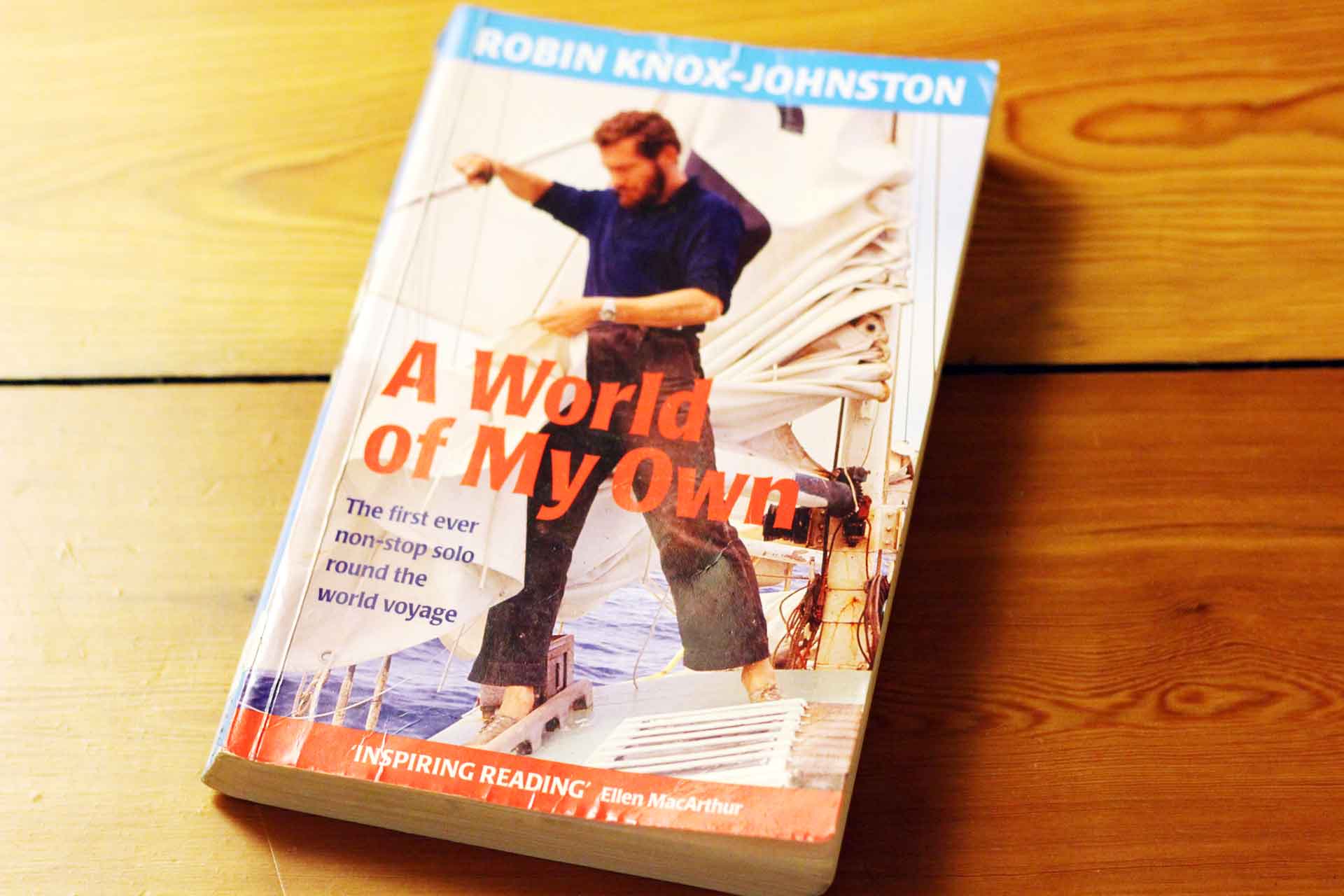It is the third of the four books I am currently reading on the events that have taken place during the 1968/69 Golden Globe Race around the World, a prize which was advertised by the Sunday Times for the first and fastest sailor who would circumvent the Earth single handed. An effort which was unprecedented and heard to imagine back in those times well before GPS navigation, EPIRB and real time weather-data by satellite downlink. Robin Knox-Johnston, who was 30 years of age when underway was later the winner of that race, earned his Knighthood of the British Empire and is still an icon of sailing in the UK. As one of the founders of the Clipper Race around the World he invented one of the most spectacular offshore adventures ordinary people, skippers and part-time sailors can undergo and if rumors are right he is going to compete in the upcoming re-enactment of the Golden Globe Race around the World. Here is what I think of his book.
Sir Robin Knox-Johnston: “A World on my own”
I read his last of the three biographies book by purpose. After consuming the tragic story of Donald Crowhurst in his trimaran TEIGNMOUTH ELECTRON and the very lyrical, almost philosophical report of Bernard Moitessier´s circumnavigation – which turned out to be a 1 ½ time around the world trip when he was skipping the sure win of the race to go for a second time – I wanted to save the story of the winner for the last, just leaving one book unread ahead, “A Voyage for Mad Men” by Peter Nichols, a review which is coming soon too.

Robin Knox-Johnston did write that book in 1969 a few month after he returned from the race and took credit for his marvelous win. As with the book of Moitessier, he combines extracts from his original log with recollections of his voyage, adds some photographs and as well as in “The Long Way” has some nice scribbles of his yacht, SUHAILI, an Indian built 31 feet wooden ketch of the Colin Archer-type. I must admit, it was a bit chewy to read through. I don´t know why. Maybe because it´s the third story of the same kind I am reading now in a row – but maybe it´s due to his writing style which I would say from my personal taste is somewhat un-exciting. But that´s my own judgement.
The Story
The story is as simple as told quickly: A big British Newspaper, the Sunday Times, offered the – back then huge – sum of 5.000 Pounds to the fastest person who would be able to sail around the world alone and without a stop: Single handed. Knox-Johnston was one of nine sailors who enlisted for this venture and later won the race. He sets sail in Falmouth, a small town at the south-eastern tip of England. He sails the classic route down south, around the Cape of Good Hope and down in the Roaring Forties on to Cape Leeuwin of Australia, chooses to go through the notorious Bass Strait and round the Southern tip of New Zealand and Cape Hoorn of course until he sets course due North again to reach Falmouth on 22nd of April in 1969 after having circumnavigated the globe in 312 days.

The book starts with SUHAILI, his 9,70 meters long ship. Her story is remarkable since she was built in India when he was stationed back there as a professional seaman for the merchant navy of Great Britain. The reader gets to know the boat very well and reads about her weaknesses Robin Knox-Johnston tried to iron out before setting sail. Some won´t reappear, some will: Such as “The Admiral”, the selfsteering gear which will fall apart completely after crossing the Great Australian Bay and a lot of trouble, leaving him with the boat steering alone just by tiller and adjusting sails correctly.
Most gripping Passage
Well, to be honest, the book hasn´t any gripping passages at all. Knox-Johnston didn´t write about epic storms or heavy water-situations, in contrary, it seems that he encountered quite unsatisfying conditions down in the southern ocean when facing light and varying winds and even calms.

The reader is confronted with his depressing moods and flaring up hopes when winds return just to be let down after realizing that winds blow from the wrong direction or with too low pressure. Nearest to being called “gripping” is a passage with heavy weather when Robin Knox-Johnston tries to sew a ripped jib. Jamming himself with both feet standing in the saloon, trying to hold himself upright, he has to hold the sail between his teeth to sew the seam with both hands. After having sewed a couple of minutes he realizes that he had sewed his mustache to the sail all along. I couldn´t hold myself from laughing some minutes imagining him sewed to the sail …
What I really like about the book. And what not
What I really liked reading Knox-Johnston was his very professional attitude during the whole voyage. When Crowhurst slowly but surely went mad over the course and Moitessier lost himself occasionally in long stretches of philosophical lectures Knox-Johnston stays cool, calm and levelheaded. Being a person of this style – and certainly this personality was one of the main reasons why he was able to win the race at last – also means that he didn´t underwent “big adventures” as the two other competitors. Or he just didn´t see it as a big adventure? The book certainly is not a booster. It´s more a review of the race. Not very emotional, funny at times but the majority of the pages could not light up a fire in me.

What was spraying sparks have been his references to the race itself, when it became clear that he had a chance of winning the Golden Globe and was desperately trying to get to know where Moitessier and the other competitors were and calculating speed and distances only to be thrown into depressions when winds stayed away. Again. In the end, Knox-Johnston´s book is a unique contemporary document worth reading. I am quite excited to see him on the way on his own old course to go around the world again and – who knows – maybe this time Sir Robin will encounter not so light winds down in the Forties …
